各种时态的主动、被动语态结构表
- 格式:doc
- 大小:32.00 KB
- 文档页数:2
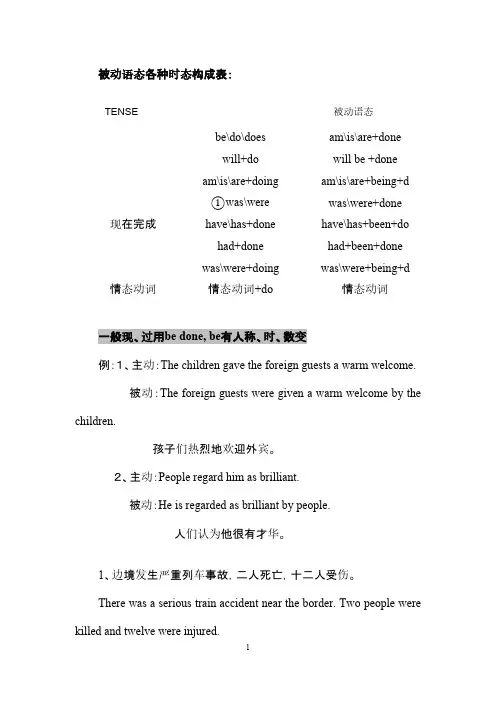
被动语态各种时态构成表:TENSE被动语态be\do\does am\is\are+donewill+do will be +doneam\is\are+doing am\is\are+being+d①was\were was\were+done现在完成have\has+done have\has+been+dohad+done had+been+donewas\were+doing was\were+being+d 情态动词情态动词+do情态动词一般现、过用be done, be有人称、时、数变例:1、主动:The children gave the foreign guests a warm welcome. 被动:The foreign guests were given a warm welcome by the children. 孩子们热烈地欢迎外宾。
2、主动:People regard him as brilliant. 被动:He is regarded as brilliant by people.人们认为他很有才华。
1、边境发生严重列车事故,二人死亡,十二人受伤。
There was a serious train accident near the border. Two people were killed and twelve were injured.2、直言不讳的人才是真正诚实的人。
A person who is truly honest is called a straight arrow.3、有人给讲演者递上来一张纸条。
A note was passed up to the speaker.4、John被选为班长而代替了亨利。
John was elected president of the class instead of Harry.5、这位战士牺牲了,然而列车得救了。

初中英语语法——被动语态用法总结归纳被动语态由助动词be加及物动词的过去分词构成,助动词be有时态,人称和数的变化。
被动语态的时态是由be的时态决定的,be是什么时态,全句就是什么时态,be动词后面的过去分词不变。
1.各种时态的被动语态结构如下:一般现在时的被动语态:主语+am / is / are (not)+过去分词一般过去时的被动语态:主语+was / were +过去分词现在完成时的被动语态:主语+have / has +been +过去分词一般将来时的被动语态:主语+will +be +过去分词过去将来时的被动语态:主语+would / should + be +过去分词过去进行时的被动语态:主语+was / were + being +过去分词过去完成时的被动语态:主语+had + been +过去分词情态动词的被动语态:情态动词+be+过去分词2.被动语态的用法(1)不知道或没有必要说明动作的执行者是谁,不用by+动作执行者短语。
Football is played widely all over the world。
全世界都广泛地踢足球。
(2)强调动作的承受者。
The bank was robbed yesterday afternoon。
昨天下午这家银行遭到抢劫。
(3)作客观说明时,常采用一种被动语态句型。
It is reported that about twenty children have died of flu in the USA。
据报道美国大约二十名儿童死于流感。
3.主动语态的句子变为被动语态的步骤(1)把原句中的宾语变为主语(2)动词改为被动形式,即be+过去分词(3)原来的主语,如果需要的话,放在by后面;如果没必要,可省略。

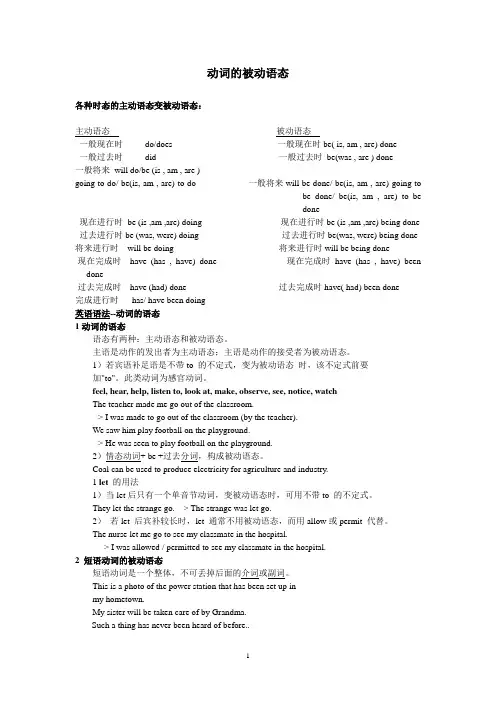
动词的被动语态各种时态的主动语态变被动语态:主动语态被动语态一般现在时do/does 一般现在时be( is, am , are) done一般过去时did 一般过去时be(was , are ) done一般将来will do/be (is , am , are )going to do/ be(is, am , are) to do 一般将来will be done/ be(is, am , are) going tobe done/ be(is, am , are) to bedone现在进行时be (is ,am ,are) doing 现在进行时be (is ,am ,are) being done 过去进行时be (was, were) doing 过去进行时be(was, were) being done 将来进行时will be doing 将来进行时will be being done现在完成时have (has , have) done 现在完成时have (has , have) been done过去完成时have (had) done 过去完成时have( had) been done完成进行时has/ have been doing英语语法--动词的语态1动词的语态语态有两种:主动语态和被动语态。
主语是动作的发出者为主动语态;主语是动作的接受者为被动语态。
1)若宾语补足语是不带to 的不定式,变为被动语态时,该不定式前要加"to"。
此类动词为感官动词。
feel, hear, help, listen to, look at, make, observe, see, notice, watchThe teacher made me go out of the classroom.--> I was made to go out of the classroom (by the teacher).We saw him play football on the playground.--> He was seen to play football on the playground.2)情态动词+ be +过去分词,构成被动语态。
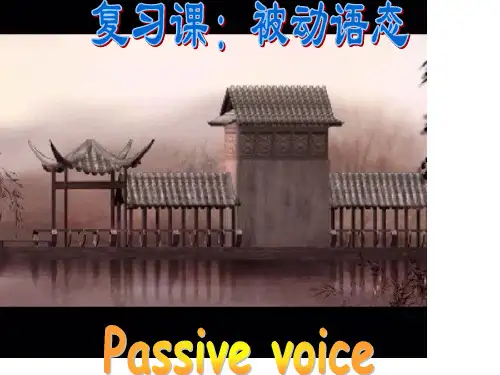
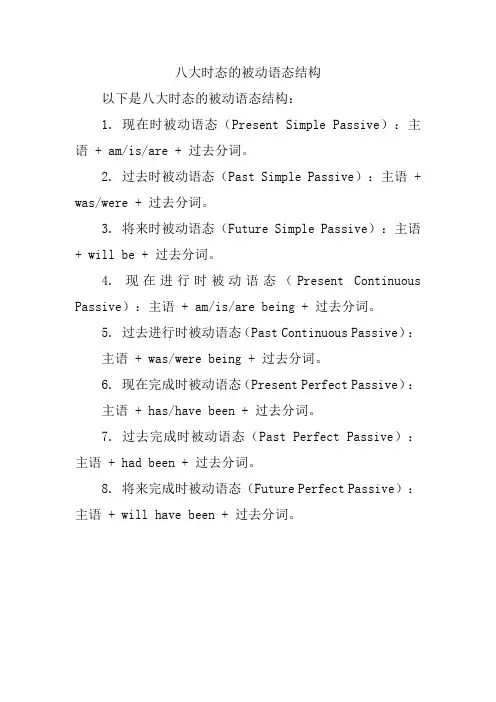
八大时态的被动语态结构
以下是八大时态的被动语态结构:
1. 现在时被动语态(Present Simple Passive):主语 + am/is/are + 过去分词。
2. 过去时被动语态(Past Simple Passive):主语 + was/were + 过去分词。
3. 将来时被动语态(Future Simple Passive):主语+ will be + 过去分词。
4. 现在进行时被动语态(Present Continuous Passive):主语 + am/is/are being + 过去分词。
5. 过去进行时被动语态(Past Continuous Passive):
主语 + was/were being + 过去分词。
6. 现在完成时被动语态(Present Perfect Passive):
主语 + has/have been + 过去分词。
7. 过去完成时被动语态(Past Perfect Passive):主语 + had been + 过去分词。
8. 将来完成时被动语态(Future Perfect Passive):主语 + will have been + 过去分词。
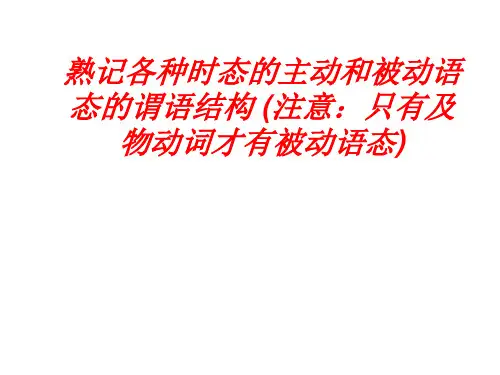
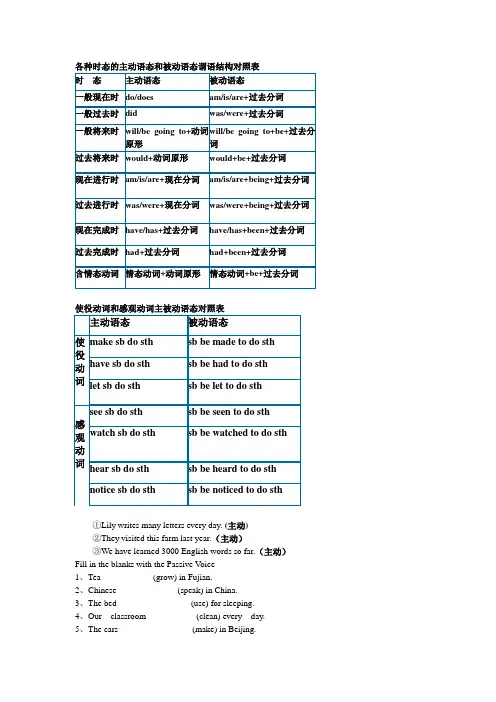
各种时态的主动语态和被动语态谓语结构对照表①Lily writes many letters every day. (主动)②They visited this farm last year.(主动)③We have learned 3000 English words so far.(主动)Fill in the blanks with the Passive V oice1、Tea _______ (grow) in Fujian.2、Chinese __________ (speak) in China.3、The bed __________ (use) for sleeping.4、Our classroom _________ (clean) every day.5、The cars __________ (make) in Beijing.6.We will build a new lab. A new lab ____ ____ _____.(主动变被动)7. The blackboard was ________ (look) carefully by the students.8 The ship model ____ be ____ (make)in two days.1.An exhibition of paintings ____ at the museum next week.A.are to be held B. is to be held C. are holding D.will be held2. I’m sorry, sir.Your recorder isn’t ready yet.It ____ in the factory.A.is being repaired B is repaired C. has been repaired D hasn’t been repaired3. A lot of people in China can speak English now . (同上)English ______ ____ ______ by a lot of people in China now.4. I have learned English for about two years. (同上)English ______ ______ ______ for about two years.5. They will publish these story-books next month. (同上)These story-books _____ _____ _____ next month.6.People there planted many trees last year.Trees _____ _____ by people there last year. (青岛市中考题)7. They grow vegetables on the farm.The vegetables _______ ______on the farm(上海市中考题)8.Our school _________in 2002.(开办)9.The young trees must____ ____ ______ well.(照顾)10. _____ this building____ _____(建成)last year?11.The book _____ _______(写)by him last year.12. The bridge _______ _______(不建造)in1989..13.The 29th Olympic Games will____ ______(举行) in UK in 2012.14. He gives me a ring. I _______ ______ a ring ____ him.15. Jack made his little sister cry again. His sister _____ ____ ____ cry again.1.被动语态练习( ) 1 The People's Republic of China __ on October 1, 1949.A. foundB. was foundedC. is foundedD. was found( ) 2 English ____ in Canada.A. speaksB. are spokenC. is speakingD. is spoken( ) 3 This English song___ by the girls after class.A. often singsB. often sangC. is often sangD. is often sung( ) 4 This kind of car ___ in Japan.A, makes B. made C. is making D. is made( ) 5 New computers ___ all over the world.A. is usedB. are usingC. are usedD. have used( ) 6 His new book___ next month.A. will be publishedB. is publishingC. is being publishedD. has been published ( ) 7 The sports meet ___ be held until next week.A. didn'tB. won'tC. isn'tD. doesn't。
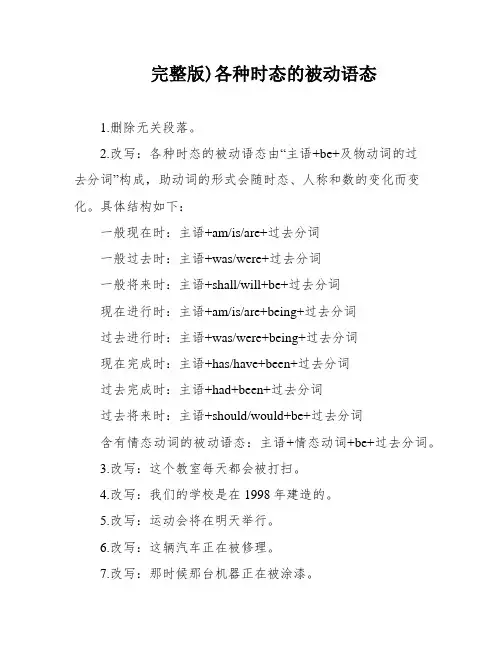
完整版)各种时态的被动语态1.删除无关段落。
2.改写:各种时态的被动语态由“主语+be+及物动词的过去分词”构成,助动词的形式会随时态、人称和数的变化而变化。
具体结构如下:一般现在时:主语+am/is/are+过去分词一般过去时:主语+was/were+过去分词一般将来时:主语+shall/will+be+过去分词现在进行时:主语+am/is/are+being+过去分词过去进行时:主语+was/were+being+过去分词现在完成时:主语+has/have+been+过去分词过去完成时:主语+had+been+过去分词过去将来时:主语+should/would+be+过去分词含有情态动词的被动语态:主语+情态动词+be+过去分词。
3.改写:这个教室每天都会被打扫。
4.改写:我们的学校是在1998年建造的。
5.改写:运动会将在明天举行。
6.改写:这辆汽车正在被修理。
7.改写:那时候那台机器正在被涂漆。
8.改写:这家银行已经建成了。
9.改写:在我来这里之前,我已经被邀请去日本访问了。
10.改写:XXX告诉我她将会被派往美国。
11.改写:这辆自行车不能放在这里。
I XXX invited so far。
so I'm not sure。
The government in our country will now record tourists' bad r。
It is XXX。
Special passive voice forms:1.When a sense verb (XXX) or a causative verb(make/let/have) is followed by an infinitive without "to" in an active sentence。
the "to" should be added in a passive sentence。

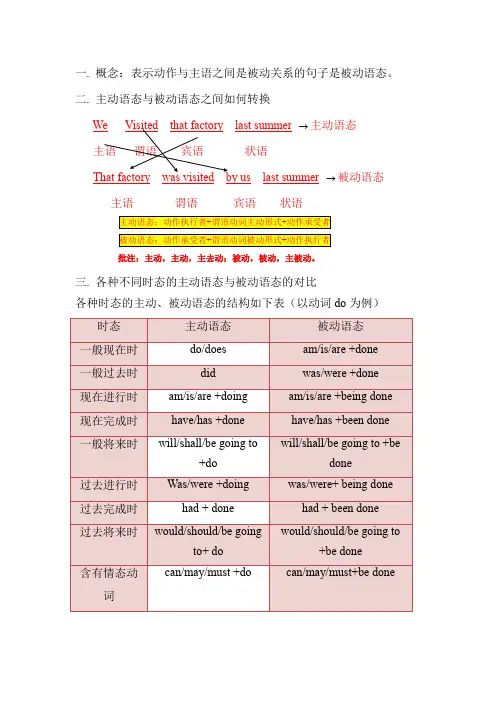
一. 概念:表示动作与主语之间是被动关系的句子是被动语态。
二. 主动语态与被动语态之间如何转换last summer →主动语态状语That factory was visited by us last summer →被动语态主语谓语宾语状语批注:主动,主动,主去动;被动,被动,主被动。
三.各种不同时态的主动语态与被动语态的对比各种时态的主动、被动语态的结构如下表(以动词do为例)具体用法:1 带双宾语的谓语动词变为被动语态① 谓语动词带双宾语时,既可以将间接宾语转化成主语,也可以将直接宾语转化成主语;② 若将间接宾语转化成主语,则保留直接宾语;③ 若将直接宾语转化成主语则保留间接宾语,且在被保留的间接宾语前加上介词to 或for ;She gave me a book. (变为被动语态)I was given a book by her.(间接宾语me 改为了主语)A book was given to me by her.(直接宾语a book 改为了主语)He often tells us interesting stories . (主动语态)⎭⎬⎫.him by us to told often are stories g Interestin .him by stories g interestin told often are We (被动语态 2动词短语变为被动语态许多由不及物动词和介词、副词构成的动词短语相当于及物动词在变为被We should speak to old men politely.Old men should be spoken to politely.3 to 的“前世今生”主动语态,某些动词后带有复合宾语,即宾语和宾语补足语,复合宾语由动词不定式充当,to 被省略,被动,to 还原。
eg. I often hear her sing this popular song .(主动语态)She is often heard to sing this popular song .(被动语态)Someone saw a stranger walk into the building.可改为A stranger was seen to walk into the building.▲ 有这种用法的常用动词有:5.初中阶段不使用被动语态的情况A.系动词无被动The dish tastes delicious. The apple smells sweet.B.某些说明名词本身性质的动词。
各种时态的被动语态一、八大时态的被动语态的构成:1.一般现在时的被动语态构成:(am/is/are +done)如:I am asked to study hard. 我被请求努力学习。
This shirt is washed once a week. 这件T恤一周洗一次。
These songs are usually sung by boys. 这些歌曲通常是男生唱的。
2.一般过去时的被动语态构成:(was/were done)如:The soldier was killed, but the train was saved. 这位战士牺牲了,然而列车得救了。
Some notes were passed up to the speaker. 有人给讲演者递上来一些纸条。
3.一般将来时的被动语态构成:(shall/will be done)如:We shall be asked a lot of strange questions. 我们将被问许多怪题。
My son will be sent to school next September. 来年九月我将送我儿子去读书。
4.过去将来时的被动语态构成:(should/would be done)如:The news would be sent to him as soon as it arrived. 消息一到就会转给他的。
He told us that the new railway would be built the next year.5.现在完成时的被动语态构成:(has/have been done)如:The work has just been finished. 工作刚刚结束。
The old rules have been done away with by us. 旧规章已经被我们废除了。
6.过去完成时的被动语态构成:(had been done)如:By last December three ships had been built by them.到去年十二月底他们已建造了三艘船。
各种时态的主动、被动语态结构表(以动词do为例)时态用法时间状语动词构成例句主动语态被动语态主动语态被动语态一般现在时1)经常性、习惯性的动作或存在的状态。
2)主语的特征、性格、能力、爱好等。
3)表示客观真often,sometimes,always,usuallyeveryday/……; onMondaysonce a week ,twice a yeardo/doesam/is/are+doneWecleantheclassroom.Theclassroomis cleanedby us.理一般过去时表示在过去某个时间发生的动作或存在的状态,也表示过去经常或反复发生的动作。
yesterday; lastw eek/…; in1990ten minutesago just nowdidwas/were+doneHeboughtmesomebooks.I wasboughtsome booksby him.Somebooks werebought forme by him.现在进1)表示此时此刻或现阶段正在进行now, thesedays等或当句中含有am/is/are+doingam/is/are+ being +doneShe iswatering theflowers.Theflowers arebeing madeby her.行或持续的动作look, listen之类的暗示词时过去进行表示在过去某一时刻或过去某一阶段正在进行的动作this timeyesterday, atthat time,then, at tenyesterday,from 7:00 to9:00 last nightwas/were+doingwas/were+ being+doneI wasplantingtreesthistimeyesterday .Trees werebeingplanted byme thistimeyesterday.一般将来表示将来要发生的动作或存在的状态tomorrow;next weekin a few daysin 2020will/shall + doam/is/are goingto + doam/is/arwill/shallbe + doneam/is/aregoing tobe + doneam/is/areWe willdiscussthisquestion inclassThisquestionwill bediscussedin classtomorrow.时 e +doing beingdonetomorrow.过去将来时表示从过去某一时间看将要发生的动作或存在的状态,常用在宾语从句中would/should +dowas/were goingto + dowas/were +doingwould/should be +donewas/weregoing tobe +donewas/werebeing +doneHe saidhewouldfinishtheworkthe nextday.He said theworkwould befinished thenext day.现在完1)表示过去发生的动作或事情对现1.already, yet,ever, never,just, before等2.和for或have/has+ donehave/hasbeen+doneTheyhavemadethe boystopThe boyhas beenmade tostop cryingalready.成时在的影响和产生的结果.它强调的是过去的动作同现在的联系。
各种情况的主动语态和被动语态一般现在时态(主2被3)1.d o/does→am done/is done/are done 一般过去时态(主1被2)2.d id(规则变化4)→was done/were done现在进行时态(主3被3)3.a m doing/is doing/are doing→am being done/is being done/are being done一般将来时态(主4被4)4.w ill do/am going to do/is going to do/are going to do→ will be done/am going to be done /is going to be done/are going to be done现在完成时态(主2被2)5.h ave done/has done6.情态动词+do过去完成时态(主1被1)7.h ad done→had been done过去将来时态(主3被3)8.w ould do/was going to do/were going to do→would be done /was going to be done/were going to be done过去进行时态(主2被2)9.w as doing/were doing→was being done/were being done 不定式的(主1被1)10.to do →to be done特殊情况:1.主动接原形,被动要加to;make sb do sth→sb be made to do sth see sb do sth→sb be seen to do sthhear sb do sth→sb be heard to do sth help sb do sth→sb be helped to do sth 2.接双宾的动词,变被动有两种情况:sb be given sth/sth be given to sbsb be made sth/sth be made for sb下列动词常用介词to:give, lend, offer, pass, send, show, tell等。
被动语态各种时态构成表:TENSE 主动语态被动语态一般现在时be\do\does am\is\are+done一般将来时will+do will be +done现在进行时am\is\are+doing am\is\are+being+done一般过去时①was\were ②did was\were+done现在完成时have\has+done have\has+been+done过去完成时had+done had+been+done过去进行时was\were+doing was\were+being+done情态动词情态动词+do 情态动词+be+done一般现、过用be done, be有人称、时、数变例:1、主动:The children gave the foreign guests a warm welcome.被动:The foreign guests were given a warm welcome by the children.孩子们热烈地欢迎外宾。
2、主动:People regard him as brilliant.被动:He is regarded as brilliant by people.人们认为他很有才华。
1、边境发生严重列车事故,二人死亡,十二人受伤。
There was a serious train accident near the border. Two people were killed and twelve were injured.2、直言不讳的人才是真正诚实的人。
A person who is truly honest is called a straight arrow.3、有人给讲演者递上来一张纸条。
A note was passed up to the speaker.4、John被选为班长而代替了亨利。
John was elected president of the class instead of Harry.5、这位战士牺牲了,然而列车得救了。